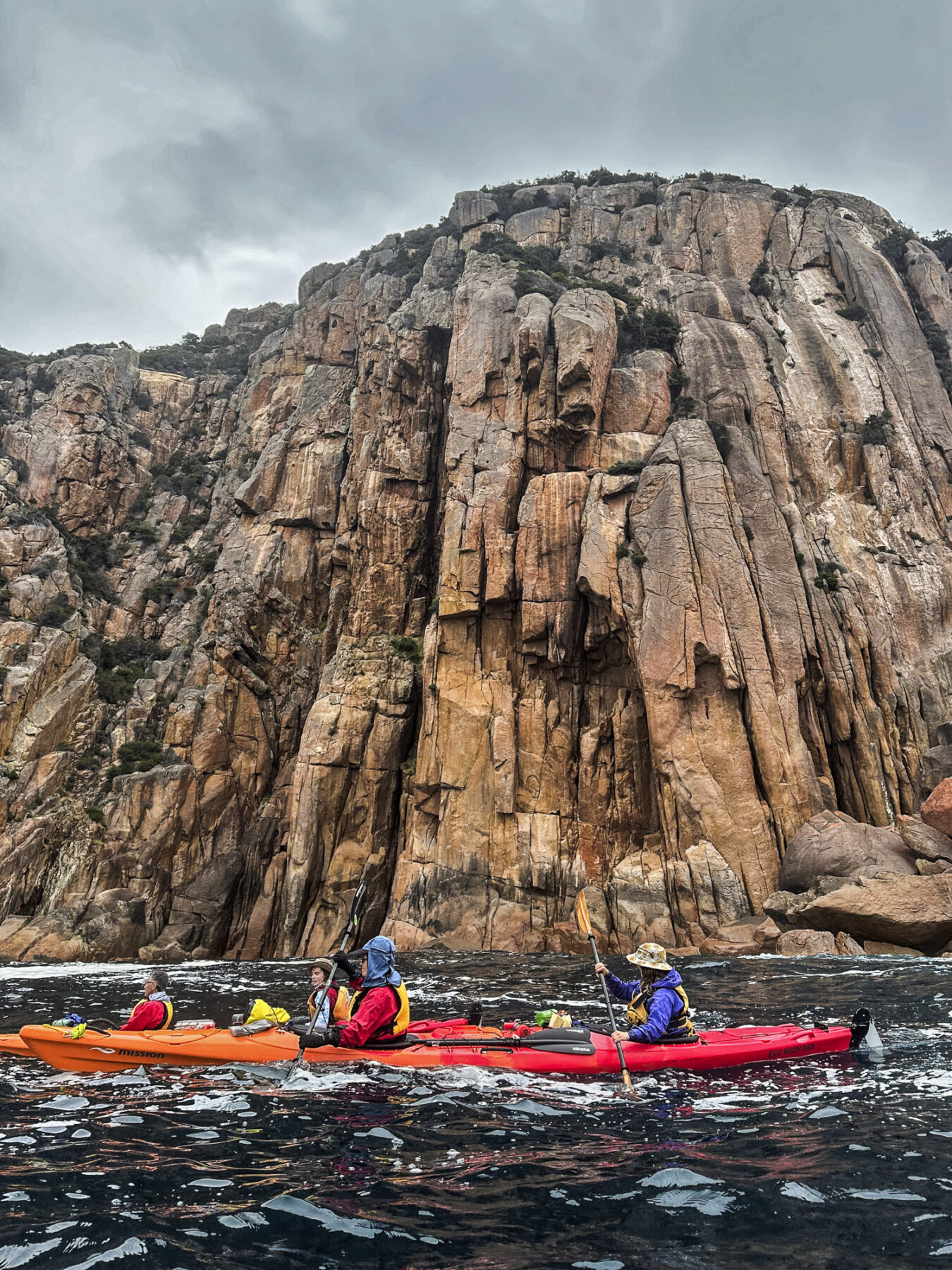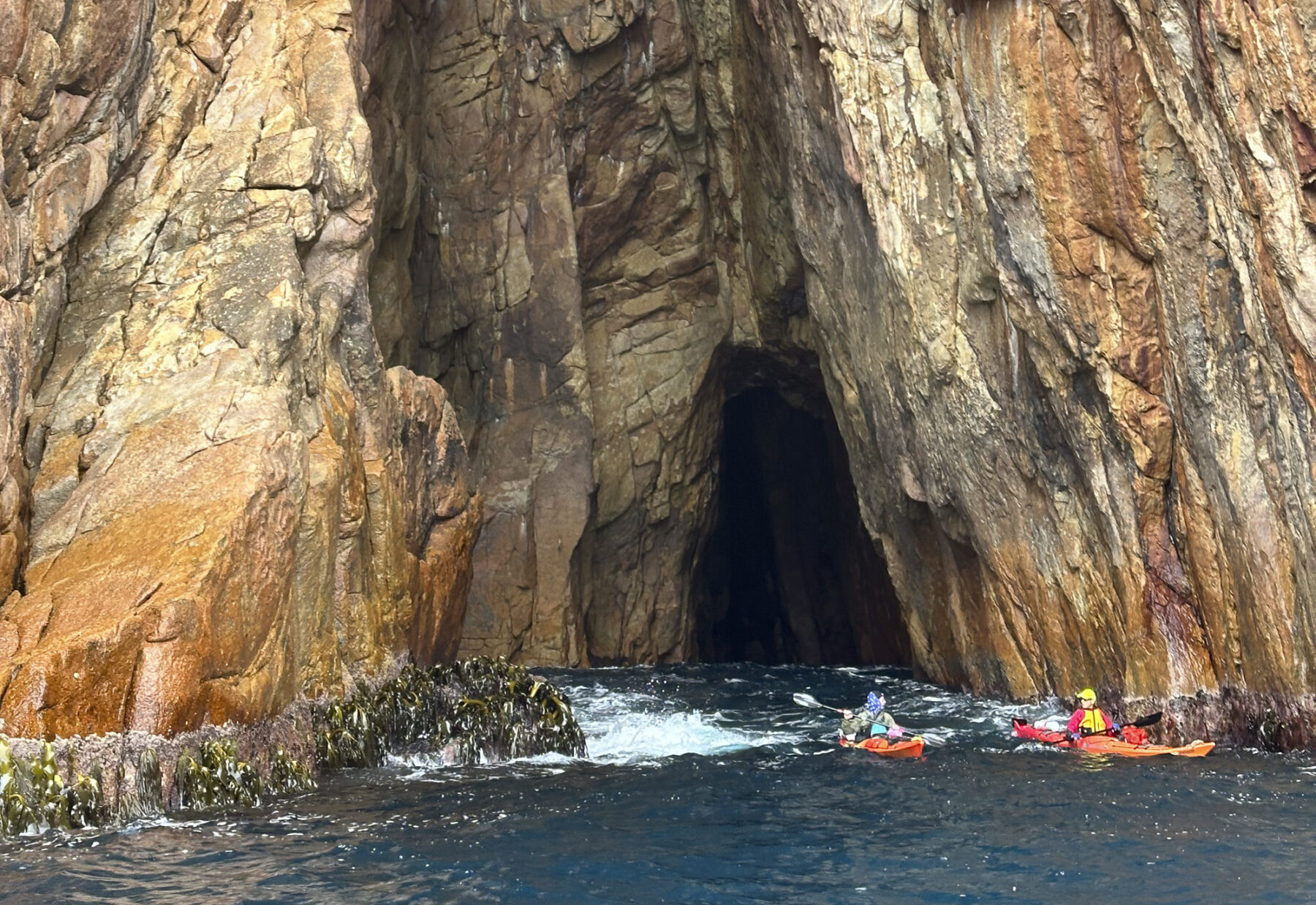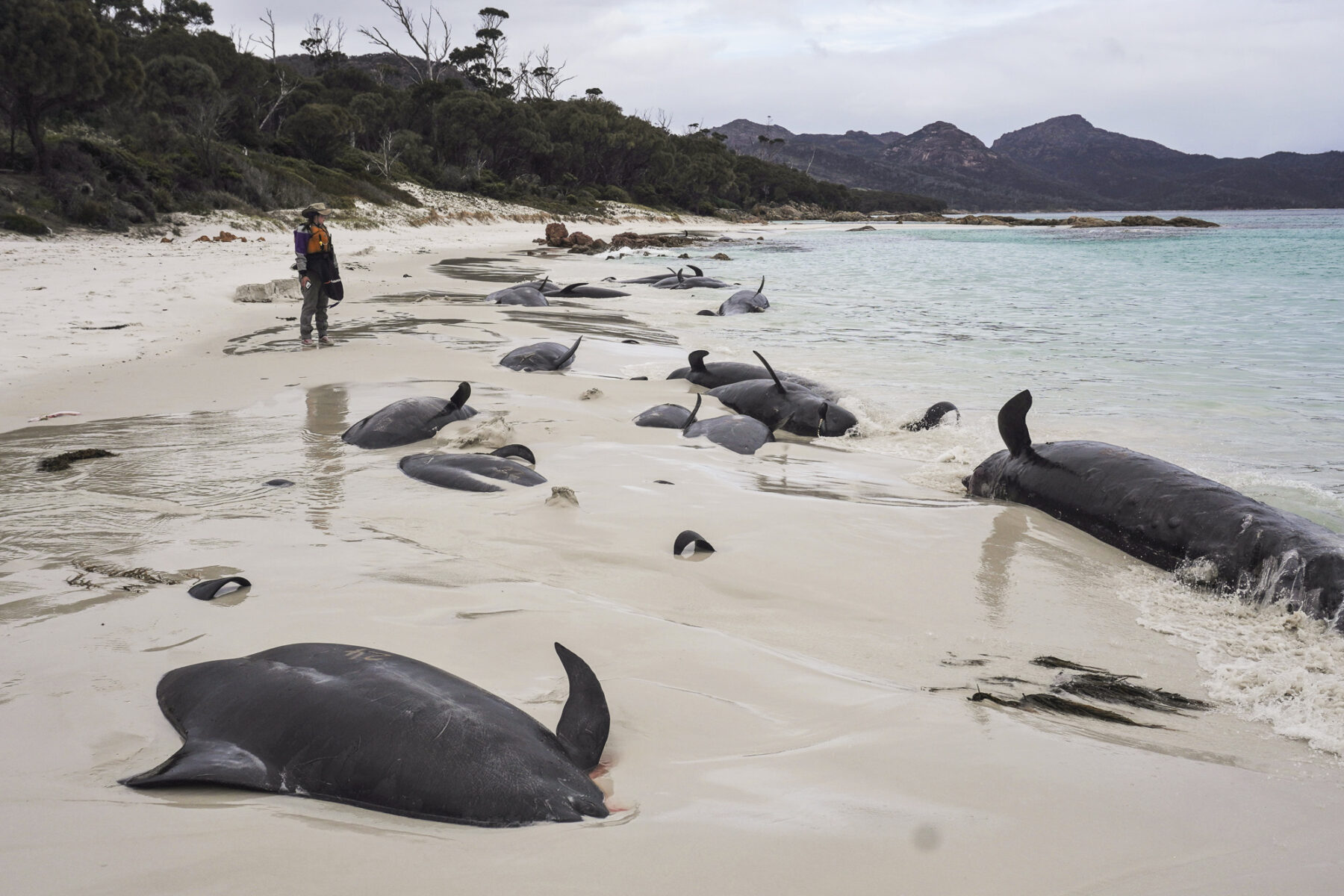You know those photos you see of kayaks floating in water so clear and calm it looks like they’re suspended in mid-air? It’s hard not to imagine yourself inside such images, which is exactly what I’m doing somewhere off the coast of Tasmania’s Freycinet Peninsula. I’m overcome by a feeling of utter peace and feel myself drifting away … carried toward the sunset on a cloud carriage … pulled by a brace of smiling unicorns … until … SPLAT! I’m slapped in the face by another fistful of the briny deep. The beguiling image, a photograph taken not far from here, is instantly dispelled. I shake salt water from my ears and resume powering through the two-metre swell.
I’m in a tandem kayak with Steve from Melbourne, 20 years my senior, with whom I’d quickly built a rapport based on mutual sarcasm. By day three, somewhere off the southern tip of the peninsula, we’re paddling as one organism, our blades plunging into the sea in perfect unison. Our fully loaded Mission Eco Niizh 565 feels as stable as a helipad, even with a sea so choppy that the other four kayaks are hidden in the troughs that divide us from the imposing cliffs of Shouten Island. I grit my teeth and focus solely on the bluff at which we’ve been instructed to aim by Elijah, our lead guide.

We feel lucky to have got this far. The example itinerary of this Southern Sea Ventures (SSV) trip runs from Coles Bay, two-and-a-half hours’ drive from Hobart, down the sheltered western coast of the peninsula and back up the ocean side’s spectacular cliffs to finish somewhere around Cape Tourville lighthouse. The six-day programme includes one contingency day for weather, and it’s probably not a good sign that we used ours on day one! It was tactfully explained on the drive up that there was little chance we’d be paddling out on the windward side of the peninsula this week. The lashing rain that chased us from our respective hotels to the SSV minibus that morning had prepared us for this news, and we took it stoically.
I’ve been on many a guided trip, as well as been a guide myself, and I consider kayak guides to be the hardest working of any in the outdoor industry. As well as paddling all day, keeping us alive, preparing our meals, and socialising for as long as we can stay awake, they also must rejig the whole itinerary based on the weather, sometimes literally hour by hour. “It’s daunting, because you don’t want to take people on an adventure into which they’ve put time and money, then be unable to fulfil their desires,” explained Katia. Our group of five clients is fortunate to have three amazing guides; as well as Elijah and 2IC Katia, we have Danika on loan from Canada.


With the promise of an easing of the southerly the following day, the first afternoon had been taken up with paddling instruction followed by a short recce along the first section of coastline. While we all had a decent amount of paddling experience, a recap of technique didn’t do anyone any harm, and a couple of hours fighting our way into 25-knot gusts did a fine job of dispelling the disappointment. Even the Wineglass Bay cruisers weren’t venturing oceanside today!
“Being wind-blasted and having to work for your keep isn’t necessarily the ideal holiday for a lot of clients,” continued Katia that evening, “Although when you’re thinking about what you’ve achieved, those are sometimes the best days. I feel the experience of punching into some of the big weather today gave us the confidence that everyone understood where we were coming from in changing the itinerary.” Indeed, finding a safe alternative that includes the epic coastline, huge granite cliffs, and big ocean we’re all here for, may be the trickiest part. “We have to figure out the best way to give everyone the ‘wow’ factor of an experience they haven’t had before,” she concluded. She needn’t have worried on that score!
On the rocks
The second morning brought the promised diminution of the weather, and with it the challenge of packing five days’ worth of food and gear into a few small-diameter cargo bins. There was a lot of twisting, ramming, and grunting involved. “Don’t worry,” said Elijah, expertly wriggling my sleep system dry bag into a cavity the size of beer can, “It gets easier as we eat our way through it.” Surprisingly, all non-personal gear was provided by SSV, and top-notch gear at that – One Planet sleeping bags and tents, Therm-a-Rest mats, Seal Line dry bags, etc. We were split into three tandems and two singles (expertly rotated over the following days to make sure everyone was satisfied with their experience). As well as Steve and his mate Bob, there was Greg, an expat Russian, and Catherine from WA, possibly the smiliest person I’ve ever met.


Over the next couple of days we pushed our way south into a not-inconsiderable 15 knot headwind, past the prestigious Freycinet Lodge and the (usually) paradisiacal Honeymoon Bay. Bold white flecks in the treetops grew into the plumage of white-bellied sea eagles as we approached, the vulnerable (in Tasmania) apex predators remaining aloof to our presence as they surveyed their domains. The shoreline of Freycinet National Park, Tasmania’s oldest, founded in 1916 and named after the French explorer Louis de Freycinet, is also home to cormorants, oyster catchers, gulls, terns and countless more bird species.
We paddled past the Hazards, a brooding range of five low mountains, their shoulders enveloped in grey cloaks. At their feet, vertical drill scars in the rock, tumbled blocks, and discarded machinery marked the site of a disused quarry, opened in 1934 to mine the peninsula’s distinctive pink granite. Tinted by naturally occurring feldspar, the rose-hued stone was once much sought after, but being hideously expensive to extract and transport, the mine eventually closed in the 1970s.
In fact, the granite is a remarkably interesting piece of the Freycinet puzzle. Elijah explained that the peninsula is mostly comprised of two huge humps of a single granite seam which extends from Hyppolyte Rocks, just off the Tasman Peninsula, north under the Bass Strait, emerging at Wilsons Promontory and continuing into the Great Dividing Range. As if that wasn’t cool enough, a fault line runs along Tasmania’s east coast, dividing it into granite and dolerite zones. This geological horizon passes through Shouten Island before splitting the headland between Cooks and Bryans Beaches into visibly distinct halves.

The northern end of Cooks Beach rewarded our second day’s efforts with a stunning campsite, the sand radiant in the elusive moments of sunshine. Quartzite dust washed into the bay reflects the light to give the water its distinctive teal colour, through which we watched southern eagle rays frolic in the shallows, just metres from shore. Foot-weary hikers rocked up in twos and threes after an exertive day on the Freycinet Peninsula Circuit. The hike has long been on my to-do list but will drop a few places now. I just can’t imagine the view from on land ever being as grand as that from the sea.
Sights, sounds and oh, the serenity
Day three was heralded as our best weather day, and we were damn well going to make the most of it. “How are your arms after yesterday?” I asked Steve. “Mine are pretty sore.”
“Yeah, not really,” he replied. “I mean, I wasn’t doing any paddling.” Cheeky git.
“Well, you sure weren’t doing any steering!” I retorted, referring to his habit of continually rear-ending our companions. (To be fair, the rudder pedals, controlled by the rear paddler, do take a bit of getting used to, as I’m to discover in my turn.)
All of which brings us back to my flight of fantasy midway across the Shouten Passage, all white caps and motion sickness triggers. Having survived the gnarly bit, we turn east to follow the shore clockwise as far as we can, immediately finding ourselves relegated to insignificant flotsam next to the soaring granite cliffs that girt the island. It becomes necessary to crane our necks to take in their full height, while the chewy blobs of lion’s mane jellyfish, the world’s largest, float below us. Fascinating sights greet us around every corner – a sea eagle eating a tern, seals lounging on the rocks, or bull kelp affixed to the cliffs’ intertidal zone by secreting a glue stronger than any man-made product. With the tide ebbing, the zone is above water, and the delicate organisms therein will be exposed to the sun for about four hours. I’m concerned they could dry out, until I remember that the chances of seeing four consecutive hours of sunshine in Tasmania is remote.
But what really makes our paddle around this coast special are the sea caves – tall, yawning cracks in the granite that reach back into the depths of the island, dark and forbidding like the lair of some ghastly ocean troll. The result of natural fault lines in the rock being exploited by aeons of crashing waves, we’re astonished when Elijah invites us to join him in exploring their outer reaches. Kayak by kayak, we back into the darkness (thus prepared for a speedy exit), rising and falling on the tumultuous waves as they roll back into the caves’ deepest corners. Each of us is thrilled at Elijah’s confidence in us to safely experience this unique perspective.


Lunch is taken on a small, pebbly beach in a cove that would rarely, if ever, have heard the sound of human voices (although we still manage to collect several plastic bottles and a football). I don’t usually gush about trip food, but in this case, it would be an injustice not to mention the team’s sterling efforts. On a single day we’re served mushroom French toast for breakfast, a nori sushi bowl at lunch, and for dinner – and a serious contender for the tastiest meal I’ve ever had camping – pasta al fungi followed by port-poached pears, all ingredients sourced locally.
Life’s sometimes sad circle
“I miss my front motor,” sighs Steve, bobbing alongside me, the bow of his single kayak nudging the tandem which I’m now sharing with Elijah. “And I miss the enormous drag factor you brought to the partnership,” I shoot back, eliciting a volley of friendly curses. After a night at Moreys Beach, we’re ‘ferry gliding’ back across the strait, a manoeuvre that involves pointing your nose into the wind, chop and swell, and aiming far in front of your desired position in the expectation that you’ll be pushed back and hit it spot on.
In a surprising twist, Elijah has announced a side trip to a freshwater lagoon behind Bryans Beach, one of the strings of such bodies formed by the dolerite/granite fault line – like a mini version of the Great Rift Valley in East Africa. We’re well on the way to Bryans when Katia spots an unusual shape in a small cove – the smooth, black form of a cetacean lying on the sand. It turns out to be a five metre-long pilot whale, a thing of beauty, presumably passed away at sea and washed up in this little corner of paradise. It’s sad, but death is part of life, and it is fascinating to see it up close.
We pay our respects and re-enter the kayaks for the last few minutes to Bryans, and it’s as we’re rounding the final rocky outcropping that the full scale of the tragedy becomes apparent. Body upon body of dead pilot whales line the sand, their lifeless forms dragging and flowing in the light surf. We lapse into a collective stunned silence as our slow progress around the rocks reveals more and more whales where none had lain only two days previously. Aghast, we run up the sand, leap out and look around us at the devastation.

“When we saw the first one, there was something in my soul hoping it was a false killer whale,” said Katia later, “because I knew if it was a pilot whale, there were going to be more. Then when we went around the corner and realised it was… It’s shocking to see mass death in something you admire, especially because it happened while we were here. On the other hand, it’s amazing to see them out of the water. It’s hauntingly beautiful to see the mechanics of a creature, especially knowing that cetaceans have brains that are arguably more advanced than ours.”
Mass whale beaching events, with pilot whales being the most common victims, are a poorly understood phenomenon, and while they’ve happened throughout history, reports of strandings have become more common in recent years. Theories encompass panicked flight from predators, disorientation from seismic events damaging the mammals’ delicate navigational organs, and heavy metal poisonings. Whatever the case, the social structure of a pod of whales is apparently so strong that the group will not be separated, even to the point of suicide. At Bryans that day, we count 43 bodies.
A story worth repeating
Considerably more subdued, we drag the kayaks across the sandbar to the lagoon, which turns out to be a beautiful distraction – a haven of greenery guarded by the glowering Mt Freycinet (assisted by a regiment of haughty black swans). Once back in the ocean, the end is in sight. After one more night at Hazards Beach, our final detour is a short stroll across the isthmus to Wineglass Bay.

As we walk, Steve and Bob are discussing coming on the exact same trip again, hopefully getting out to peninsula’s east coast next time. They’re already booked on another adventure with SSV, a nine-day jaunt around Fiji’s Yassawa islands the following October. Freycinet has only served to confirm they’ve chosen their company wisely. By the time we reach Coles Bay and a celebratory glass of bubbles, Greg has been convinced to join them, and days later Katherine also signs up, along with her partner. It’s surely rare that an entire client group, strangers beforehand, immediately book another trip together. What better endorsement could there be?
The writer was a guest of Southern Sea Ventures.
